The global retail industry is rapidly growing and is expected to reach $32.8 trillion in 2026. This shows the competition is at an all-time high, and retailers need a robust facility management solution to stay ahead. That’s where AI in CAFM can be instrumental.
By utilizing the power of artificial intelligence, CAFM solutions can transform retail facility management. This enables retailers to optimize operations, enhance customer experiences, and drive business growth.
This article will discuss the details of AI in CAFM and how it revolutionizes the retail sector facility management.
How to Integrate AI in CAFM?
Integrating AI in CAFM can bring numerous benefits to your business, ranging from cost savings to task automation. That’s why AI in the retail market is evolving quickly and is expected to hit $29.45 billion by 2028.
The process for incorporating AI in CAFM for your retail sector is given as follows:
Clearly Define Your Objectives and Use Cases
Retailers should clearly define their objectives, such as what they want to achieve through AI integration in CAFM. They should determine what specific problems or challenges they want to address.
These can be optimizing maintenance schedules, improving energy efficiency, or enhancing customer experiences. Once they identify their objectives and know the AI use cases in CAFM, they can ensure that the AI integration aligns with their business goals and delivers tangible benefits.
Data Collection and Integration
AI relies heavily on data, so retailers should focus on collecting and adding data to the AI model or algorithm. For this, they should gather data from sources like the retail store’s sensors, building management systems, equipment maintenance records, and other safety regulations. This data will decide how the AI models are going to work for the retail store.
Data Quality and Processing
AI requires clarity in data for generating optimized outputs. So, retailers should clear the data from any inconsistencies and outliers. This may involve identifying and correcting missing values, standardizing formats, and removing duplicate entries.
Select AI Techniques
There are plenty of AI techniques, like:
- Natural Language Processing: Enables computers to understand, interpret, and generate human language.
- Machine Learning: Algorithms or technology that allow computers to learn from data and make predictions without being explicitly programmed.
- Deep Learning: A subset of ML based on artificial neural networks in which multiple processing layers are used to collect complex features or information from data.
- Computer Vision: Allows computers to interpret and analyze visual information from images or videos.
Retailers can pick these solutions based on their particular needs.
Train the AI Models
Finally, retailers need to train AI models as per the preprocessed data to unlock a world of intelligent functionalities. This process involves feeding the AI with data such as maintenance records, occupancy patterns, and other pertinent sources. Once trained, these models can offer valuable insights into facility management, enhancing decision-making.
Here’s how:
- Train the AI model for preventive maintenance by giving it information about the manufacturer’s maintenance guidelines for equipment. It will safeguard retailers from the 44% unscheduled downtime attributed to lack of maintenance.
- For energy optimization, use AI algorithms that help automatically optimize heating and cooling systems as per weather forecast.
Tip: Keep updating these models to adapt to changing retail conditions and maintain their effectiveness over time.
How AI in CAFM Transforms Retail Space Management?
The following are the points that highlight how AI in CAFM can take retail space management to the next level:
-
Optimizing Store Layouts
AI in CAFM uses advanced algorithms and analytics to provide retailers with information about optimizing store layouts. Retailers can get data on arranging products, aisles, and displays to capture customer attention.
For instance, AI algorithms can analyze factors like foot traffic patterns, sales data, and customer behavior to suggest the most effective layout for retail space. This helps maximize customer flow, enhances the visibility of products, and ultimately improves sales.
A recent study solidifies this claim that computer vision-based technology in retail helps retailers by enhancing store layout, product positioning, and store layout based on customer interests. It creates heat maps of customer movement and visualizes high-traffic areas of the store. The retailer can use this data for strategic product placement and identification of areas that require improvement.
-
Inventory Management and Stock Placement
AI paired with CAFM also helps in space management by optimizing inventory and its placement. Al algorithms track inventory in real-time, allowing retailers to keep a check on stock availability. This prevents understocking, which may cost your business 4.1 percent of lost revenue, and overstocking is responsible for a 3.2 percent loss in revenue.
-
Identifying Underutilized Spaces
There are plenty of underutilized spaces in retail stores. AI in CAFM identifies such spaces by analyzing foot traffic patterns, sales data, and occupancy rates. For instance, AI can detect sections of the store that see low foot traffic or sales volume compared to other areas.
It also finds understocked shelves, indicating inefficiencies in space management. This information helps retailers proactively redesign the layout. They can reallocate products or introduce new features to utilize the often overlooked spaces.
This is also proven by a study of a retail store that benefitted from the AI-based solution in retail management and operational efficiency. The AI solution provided shelf images to generate a reference table of shelf statuses, prioritized shelves for replenishment based on empty space and identified products needing replenishment. The implementation of this solution offered the retail store a 90% accuracy in product identification and 95% in prioritization of shelves for replenishment.
Case Study
The X retail store in the US was struggling with space utilization. The team at X struggled to optimize layouts per customer demands and could not keep track of inventory. This resulted in understocking that impacted customer experience.
X reached out to Auberon Technology to find a solution for all these issues. The Auberon Technology CAFM, which has robust AI features, perfectly handled all the space management demands of the X store.
It helped them redesign the store’s layout per customer foot traffic and demand. It also offered insights into customer behavior so X could provide a personalized shopping experience. As a result, there was a spike in overall sales and revenue.
Conclusion
Integrating AI in CAFM isn’t a complex procedure if retailers follow the implementation steps properly. They should have clear objectives and then proceed to collect and process data and choose the right AI technique for the retail store. AI CAFM facilities management offers plenty of benefits to retailers, including space optimization and inventory tracking to identify underutilized spaces.
If you want the best CAFM systems for retail space management, get in touch with Auberon Technology. We offer high-quality CAFM solutions, having advanced features that allow efficient space optimization and a positive customer experience.
Citations
Global retail sales 2021-2026 | Statista. (2023, September 29). Statista. https://www.statista.com/statistics/443522/global-retail-sales/
ReportLinker. (2023, August 18). Artificial Intelligence in Retail Market Size & Share Analysis – Growth Trends & Forecasts (2023 – 2028). GlobeNewswire News Room. https://www.globenewswire.com/news-release/2023/08/18/2727938/0/en/Artificial-Intelligence-In-Retail-Market-Size-Share-Analysis-Growth-Trends-Forecasts-2023-2028.html
2018 Maintenance Survey: Playing offense and defense. (2021b, April 18). Plant Engineering. https://www.plantengineering.com/articles/2018-maintenance-survey-playing-offense-and-defense/
Ryan, T. (2015, May 15). Retailers suffer the high cost of overstocking and out-of-stocking – RetailWire. RetailWire. https://retailwire.com/discussion/retailers-suffer-the-high-cost-of-overstocks-and-out-of-stocks/
Soni, V. (2021). Deep Learning and Computer Vision-Based Retail Analytics for Customer Interaction and Response Monitoring. Eigenpub Review of Science and Technology, 5(1), 1-15.
Siddappa, S., & Hegde, V. K. G. (2023). Artificial intelligence and technology for operational efficiency in retail stores. International Journal of Big Data Management, 3(1), 51-65.










